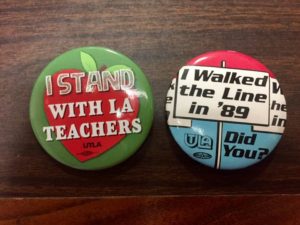 I walked the line in ’89. I was a teacher in Los Angeles Unified School District when the teachers’ union (UTLA) led the last teachers’ strike. Thirty years later, I see things from a somewhat different angle. I’m happy to report one big difference between 1989 and now: LA teachers asked for – and won – much more than a modest and well-deserved pay raise for themselves. They advocated loudly and clearly for the rights of children and families in a public education system that has been severely eroded over the years since I left the classroom.
I walked the line in ’89. I was a teacher in Los Angeles Unified School District when the teachers’ union (UTLA) led the last teachers’ strike. Thirty years later, I see things from a somewhat different angle. I’m happy to report one big difference between 1989 and now: LA teachers asked for – and won – much more than a modest and well-deserved pay raise for themselves. They advocated loudly and clearly for the rights of children and families in a public education system that has been severely eroded over the years since I left the classroom.
In 1989 conditions in schools were challenging too, but those problems weren’t up front and center in the strike rhetoric. Then, one of the biggest issues was overcrowding. I worked in a multi-track, “year-round” school, where three classes shared two classroom spaces, rotating between them – and shuffling all our materials – as each class came on for two months and then off for one throughout the year. Then, as now, we were short-staffed on support services. Once a week we had access to a school psychologist, whose main job was to conduct testing, not secure services for kids who had experienced multiple traumas in the new-immigrant, high poverty school where I worked. There was only one part-time nurse on duty to serve a school of 700 kids. Students were not allowed to run on the asphalt playground for fear of the scraped knees that could result. (And in schools with high levels of trauma, nurses play important roles in terms of providing kids some respite from psychosomatic illnesses.)
Thirty years later, overcrowded schools are not the biggest problem LA schools face. That is in large part due to gentrification and the exodus of students from public to private or charter schools – the continuation of a long process of “white flight” and a growing abandonment of everything public by those with the means to buy services. But overcrowded classrooms are a real problem, with upwards of 45 students squeezing into many classrooms. And support staff has shrunk even more. The strike called attention to these issues. The resolution of the strike does not mean that these problems are resolved, but at least there is an awareness of them, and some effort to address them.
In the 1980s there were groups within UTLA who advocated for the rights and needs of the children and families. I worked with the Teachers Committee on Central America to support children whose families had fled civil war in their home countries — wars that were fueled with U.S. dollars and that left a legacy of violence that reverberates in the current migration crisis, which in turn shows up as trauma in our schools. In the Human Rights Committee, we highlighted the U.N. Convention on the Rights of the Child, which calls for devotion to the best interests of all children, regardless of nationality, and for protections for children’s health, education and well-being. This convention has been ratified by all members of the United Nations except the United States.
The advocacy work for children and families that was relegated to special UTLA committees in the past are at the center stage today. The union made the issues of investment in community schools, special education, early childhood and bilingual education central to the strike. From my current standpoint, I know that there are no easy solutions to entrenched social inequities. But Los Angeles teachers gave us all the opportunity to publicly ratify the human rights of teachers, families and all children, and to call for an end to the erosion of public education in the second largest school district in the nation. Thank you to UTLA and to the teachers of LAUSD.